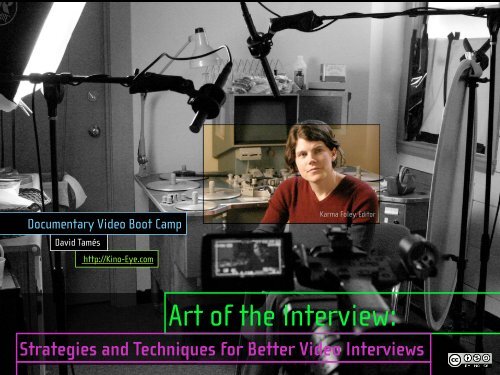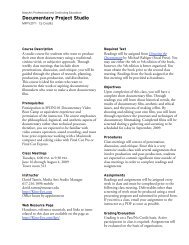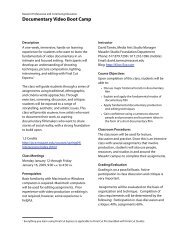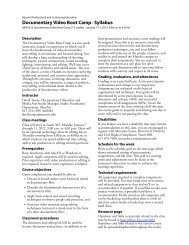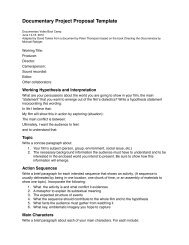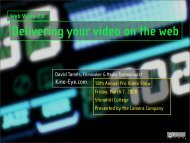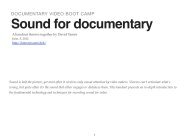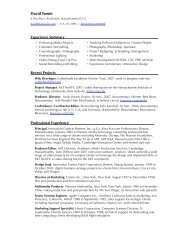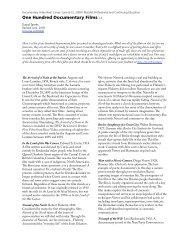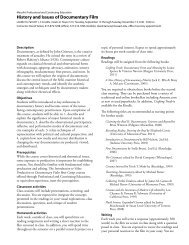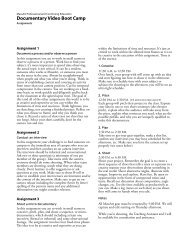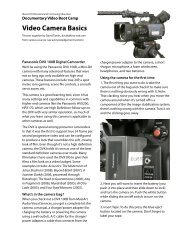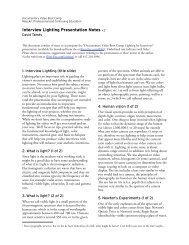Art of the Interview Slides
Art of the Interview Slides
Art of the Interview Slides
You also want an ePaper? Increase the reach of your titles
YUMPU automatically turns print PDFs into web optimized ePapers that Google loves.
Documentary Video Boot Camp<br />
David Tamés<br />
http://Kino-Eye.com<br />
Karma Foley, Editor<br />
<strong>Art</strong> <strong>of</strong> <strong>the</strong> <strong>Interview</strong>:<br />
Strategies and Techniques for Better Video <strong>Interview</strong>s
Many, styles, approaches, choices...<br />
Style<br />
• Informal<br />
• Formal<br />
Relationship<br />
with <strong>Interview</strong>ee Style<br />
Position Direction <strong>of</strong> Gaze<br />
• Pr<strong>of</strong>essional<br />
• Personal<br />
• Adversarial<br />
• Planned<br />
• Improvisational<br />
• Stand-Up<br />
• Sit-Down<br />
• Walk & Talk<br />
• MOS<br />
• Direct<br />
• Off-Camera<br />
Location<br />
• Event<br />
• Studio<br />
• Home<br />
• Office or Lab<br />
• In <strong>the</strong> Street<br />
• In <strong>the</strong> Wild
Videoblogging aes<strong>the</strong>tic<br />
Contemporary influences on interview style<br />
blip.tv<br />
http://blip.tv<br />
O<strong>the</strong>r Styles:<br />
• Broadcast News<br />
• Celebrity Show<br />
• Documentary<br />
• Testimonial<br />
• Behind-<strong>the</strong>-scenes<br />
• Conversation<br />
• Personal<br />
David Tamés http://kino-eye.com
1. Always get a signed personal release form<br />
The Seven Habits <strong>of</strong> Highly<br />
Successful <strong>Interview</strong>ers<br />
2. Do research & preparation, pre-interview if applicable<br />
3. Empathy and respect<br />
4. Follow up on what excites your interviewee<br />
5. Active listening: maintain, eye contact, don't cut people <strong>of</strong>f ...<br />
6. <strong>Interview</strong> to elicit STORIES from people, not just information<br />
7. Allow pauses, sometimes yields more, and better room tone too!<br />
Assumption: we’re getting good image and sound as a baseline.<br />
Photo <strong>of</strong> Steve Garfield<br />
http://stevegarfield.com
Direct or <strong>of</strong>f-camera gaze?<br />
Direct gaze<br />
<strong>Interview</strong>ee appears to be talking<br />
directly to <strong>the</strong> viewer, can provides <strong>the</strong><br />
illusion <strong>of</strong> no interviewer in some cases<br />
Video: Class <strong>of</strong> 2007 Journey to MIT<br />
http://techtv.mit.edu/videos/678-class-<strong>of</strong>-2007-spanclasshighlightjourneyspan-span-classhighlighttospan-mit<br />
Off camera gaze (conventional)<br />
<strong>Interview</strong>ee appears to be talking<br />
with someone <strong>of</strong>f-camera, we may or<br />
may not see this "third person"<br />
Student Activities Midway (from MIT ZigZag #10)<br />
http://libstaff.mit.edu/amps/zigzag/?p=8
The connection between interviewer and interviewee can be enhanced with <strong>the</strong><br />
prompter-cam (a.k.a. Interrotron, pioneered by Errol Morris), resulting in<br />
(possibly) a more intimate connection between interviewee and viewer.<br />
Behind <strong>the</strong> scenes photo <strong>of</strong> "Class <strong>of</strong> 2007 Journey to MIT"<br />
http://techtv.mit.edu/videos/678-class-<strong>of</strong>-2007-span-classhighlightjourneyspan-span-classhighlighttospan-mit<br />
Prompter Cam
The interviewee sees <strong>the</strong> interviewer in <strong>the</strong> camera...<br />
Behind <strong>the</strong> scenes photo <strong>of</strong> "Class <strong>of</strong> 2007 Journey to MIT"<br />
http://techtv.mit.edu/videos/678-class-<strong>of</strong>-2007-span-classhighlightjourneyspan-span-classhighlighttospan-mit<br />
Prompter Cam
... and <strong>the</strong> interviewer sees <strong>the</strong> interviewee in <strong>the</strong> prompter, a<br />
two-way video conference between <strong>the</strong>m, resulting in <strong>the</strong><br />
interviewee engaging in an face-to-face conversation with <strong>the</strong><br />
interviewer and <strong>the</strong> viewer perceiving <strong>the</strong> interviewee is talking<br />
and looking directly to <strong>the</strong>m.<br />
Behind <strong>the</strong> scenes photo <strong>of</strong> "Class <strong>of</strong> 2007 Journey to MIT"<br />
http://techtv.mit.edu/videos/678-class-<strong>of</strong>-2007-span-classhighlightjourneyspan-span-classhighlighttospan-mit<br />
Prompter Cam
Tech Tips<br />
Suggested Compression Tele-prompter<br />
Settings<br />
C2<br />
C1<br />
<strong>Interview</strong>ee<br />
C1: Close-Up<br />
C2: Medium Shot<br />
Two camera prompter cam setup, shooting CU and<br />
MS at same time makes editing easier.<br />
Monitors<br />
Behind <strong>the</strong> scenes photo <strong>of</strong> "Class <strong>of</strong> 2007 Journey to MIT"<br />
http://techtv.mit.edu/videos/678-class-<strong>of</strong>-2007-span-classhighlightjourneyspan-span-classhighlighttospan-mit<br />
Prompter Cam<br />
Tele-prompter<br />
Director
<strong>Interview</strong>ing Tips<br />
<strong>Interview</strong>ees are talking with you, not <strong>the</strong> camera, not <strong>the</strong> crew<br />
Don't just run through a list <strong>of</strong> questions, that's a formula for boredom,<br />
questions are just to help you keep things going; conversation, stories, and<br />
following up on what your interviewee is excited about is more important<br />
Don't have people restate, ra<strong>the</strong>r, ask for clarification or an explanation <strong>of</strong> <strong>the</strong><br />
thing you want <strong>the</strong>m to restate, much better for conversation flow<br />
Make sure your interviewee has access to water (room temperature or cool, not cold)<br />
S<strong>of</strong>t Rembrandt lighting is not only more dimensional, but <strong>the</strong> key is less<br />
direct on <strong>the</strong> interviewees eyes, thus more comfortable for <strong>the</strong>m<br />
More tips at http://kino-eye.com/2006/01/23/notes-on-<strong>the</strong>-interview/
Working with Transcripts<br />
Makes editing much easier for longer pieces<br />
Scanning transcripts is faster than scanning video<br />
However, don't just write a script based on transcript<br />
excepts, focus on structure and visual storytelling
Suggested Viewing<br />
The Fog <strong>of</strong> War...<br />
Errol Morris...<br />
In <strong>the</strong> Shadow <strong>of</strong> <strong>the</strong> Stars<br />
Allie Light & Irving Saraf<br />
Shadow <strong>of</strong> <strong>the</strong> House<br />
Allie Humenuk<br />
The Blues Accordin’ to Lightnin’ Hopkins<br />
Les Blank
Suggested Reading<br />
All I Did Was Ask by Terry Gross<br />
Directing <strong>the</strong> Documentary by Michael Rabiger<br />
Making Documentary Films & Reality Videos by Barry Hampe<br />
“If I have seen far<strong>the</strong>r it is because I stand on <strong>the</strong> shoulders <strong>of</strong> giants.” — Isaac Newton
Photos Video Examples<br />
Karma Foley <strong>Interview</strong> (from Remembering John<br />
Marshall) by David Tamés<br />
http://www.flickr.com/photos/kino-eye/226951415/<br />
Theology books, Bristol library<br />
by Andrew Eason<br />
http://flickr.com/photos/andreweason/8815257/<br />
Handycam<br />
by Kevin Chan<br />
http://www.flickr.com/photos/crumbs/113223965/<br />
WMMO<br />
by Lee Bennett<br />
http://www.flickr.com/photos/leebennett/388421489/<br />
Half Nelson audience at IFFB courtesy <strong>of</strong><br />
Adam R<strong>of</strong>fman, Independent Film Festival <strong>of</strong> Boston<br />
http://www.iffb.org<br />
All o<strong>the</strong>r photos herein by David Tamés<br />
http://www.flickr.com/photos/kino-eye/<br />
Copyright<br />
Class <strong>of</strong> 2007 Journey to MIT<br />
Produced by Chris Boebel and David Tamés<br />
http://techtv.mit.edu/file/170/<br />
Student Activities Midway (excerpt from MIT ZigZag #10)<br />
Produced and Edited by David Tamés<br />
http://libstaff.mit.edu/amps/zigzag/?p=8<br />
Remembering John Marshall<br />
Directed by Alice Apley & David Tamés<br />
http://kino-eye.com/rjm/<br />
Smile Boston Project<br />
Directed by David Tames<br />
http://kino-eye.com/smile/<br />
Copyright 2009 by David Tamés, Some Rights<br />
Reserved. Released under a Creative Commons Attribution-<br />
Noncommercial-Share Alike 3.0 License. For attribution, please link to:<br />
http://kino-eye.com/<br />
Product photos and DVD covers copyright by <strong>the</strong>ir respective owners and used<br />
according to accepted fair-use guidelines and are excepted from <strong>the</strong> Creative<br />
Commons Share-Alike licensing.


